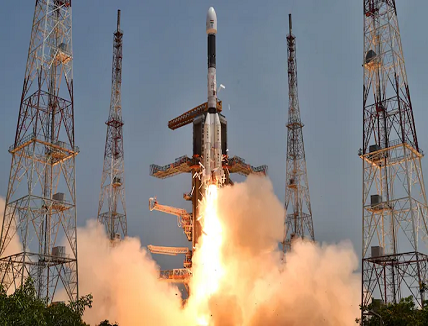
ISRO next-gen Navigational Satellite NVS – 01 incorporates L1 band signals & aims to provide real-time positioning & timing services
The Indian Space Research Organisation (ISRO) successfully launched the next-generation Navigational Satellite NVS – 01 on Monday, 29th May 2023. The lift off took place from the Sathish Dhawan Space Centre, Sriharikota (Andhra Pradesh) on-board an expandable GSLV Geosynchronous Launch Vehicle at 10.42 am. Nearly 20 minutes after the flight, the GSLV rocket deployed the NVS – 01 Satellite at an altitude of about 251 km in a Geosynchronous Transfer Orbit (GTO).
This latest mission of ISRO continues the legacy of NavIC (Navigation with Indian Constellation) services to meet the nation’s positioning, navigation and timing requirements while providing new service in L1 band. It is the fifth launch of the year from ISRO and 15th flight of the 51.7 metre tall Geosynchronous Satellite Launch Vehicle, GSLV. This mission is the sixth operational flight of the GSLV rocket with indigenous cryogenic stage.

Navigational Satellite NVS – 01
Navigational Satellite NVS – 01 is the first in the series of five next-generation NavIC satellites. This series of the satellite incorporates L1 band signals to widen the services and carries an indigenous Rubidium atomic clock developed by the Space Applications Centre, Ahmedabad.
Equipped with the enhanced features, the Navigational Satellite NVS – 01 aims to get real-time positioning and timing services over India and a region approximately 1,500 km around the mainland of the country. The satellite is powered by two solar arrays, having a capability of generating power up to 2.4 kW along with a Lithium-ion battery that is responsible for supporting payload and bus load during eclipse. ”The satellite employs both passive and active thermal management, unified bi-propellant propulsion system and three-axis body stabilised zero momentum system with reaction wheels,” ISRO said. It will provide a user position accuracy better than 20 meters and timing accuracy better than 50 nanoseconds.
The 2232-kilogram satellite carried navigation payloads L1, L5 and S bands and included features like aerial, terrestrial, precision agriculture, maritime navigation, IoT, fleet management, and location based services in marine fisheries, mobile devices and others. According to ISRO, the signals will be more secure as the civilian frequency band has been introduced in the satellite. Designed particularly for the growing demands of the civil aviation and military sector requirements, the mission life of Navigational Satellite NVS – 01 is expected to be better than 12 years.
ISRO Chairman S. Somanath congratulated the team behind this mission and said, “This mission happened after the debacle that we had in the F10 mission where there was an issue in the cryogenic stage. I’m very happy about the corrections and modifications that we have done in this stage as well as the lessons that we learnt out of it to make our cryogenic stage more reliable.” The Indian Space Agency is planning to launch INSAT-3DS weather satellite with GSLV and aims to launch four more NVS series satellites to complete the navigation satellite constellation NavIC.



















